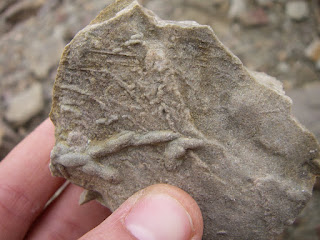Intro
Phew! This is truly the flagship among evolutionary progresses and one single post surely cannot embrace a topic that provides enough material to fill up book shelfs. In the course of writing this post it became more and more apparent that it is by far too simplistic just to tell that the presence of trace fossils proves that complex bilateral animals inhabited the sea floor long before they are found in decent body fossil faunas. Although this statement would be the very essence in order to maintain the idea of "traces first", the comparison of these two archives and stating that one predates the other is like comparing the incomparable. I will, anyhow, try to emphasize the role of the ichnology in this event later but first I need to take a deep breath and one step back to provide a minimum of framework.
Phew! This is truly the flagship among evolutionary progresses and one single post surely cannot embrace a topic that provides enough material to fill up book shelfs. In the course of writing this post it became more and more apparent that it is by far too simplistic just to tell that the presence of trace fossils proves that complex bilateral animals inhabited the sea floor long before they are found in decent body fossil faunas. Although this statement would be the very essence in order to maintain the idea of "traces first", the comparison of these two archives and stating that one predates the other is like comparing the incomparable. I will, anyhow, try to emphasize the role of the ichnology in this event later but first I need to take a deep breath and one step back to provide a minimum of framework.
The first and most obvious message: The "Cambrian Explosion" is a term describing the sudden appearance of numerous "modern" phyla in the fossil record. Nothing more and nothing less. This statement is, in a way, the lowest common denominator of the CE-research, because it just outlines the plain observation. Some people confuse the sudden appearance with absolute evolutionary progress. This might be true but actually this is just one way to interpret it. Although much research has been devoted, it still remains enigmatic in several concerns. But it has been proven that the appearance of complex organisms in the fossil record is one of the last chain links in a cascade of modifications in the earth system. Steps of such an impact are not "sudden" nor do they result from a single causative event. The Cambrian radiation (I like this term better) has a (even on the geological time scale) long and complex prologue. So when did it really start?
Deck the hall with boughs of holly, Fa la la la la la, la la la la.
When does Christmas start? Some people may say at first Christmas holiday when the children get up early to receive their gifts. Other (german) people may say: No, it's on Christmas eve already. You see, it is a local phenomena. However, this is not the whole story. You have to go and get a tree, bake cookies, buy and prepare all the food, invite your relatives, tell Santa what to get for your kids, set up the decoration, make everything shiny etc. pp. In Germany, we have all this tradition like the "Weihnachtsmarkt" (Christmas market?), Nikolaus and so on. This stuff probably all belongs to Christmas as same as Santa Claus, presents and the tree at Christmas eve itself, doesn't it? Yes, for sure, but the true point of no return is when your children and all other relatives unwrapped their presents and gifts and everyone is happy with his/her new toy, jewellery, fragrance, shirts, socks, ties etc. The living room is a mess, everyone is drinking wine, the turkey is torn into pieces, your cat is going crazy and over the next days, you will have to go and visit all the other people you missed for the whole year probably. Although these are holidays, everyone is very busy. But as I noted above, there is many stuff going on in the "advent" of this event already. It requires much preparation to make all this happen and if one parameter is missing, it cannot really be Christmas then for some people.
My opinion: If we look at the beautiful fossil lagerstätten like Chengjiang and Burgess Shale, we see the holidays - the very essence of the event, when everyone is busy, has new toys to experiment with and so on. In some concerns this analogue might not be very appropriate but I think it is very instructive and fairly outlines the complexity. From all what we know (and I read), one cannot really say: "here it all started". It was a process.
 Fig. 2: Treptichnus cf. pedum from the lower Middle Cambrian of Jordan. This is not a very typical specimen. We found it during the field session in Jordan. Photo courtesy of G. Mángano.
Fig. 2: Treptichnus cf. pedum from the lower Middle Cambrian of Jordan. This is not a very typical specimen. We found it during the field session in Jordan. Photo courtesy of G. Mángano. Trace fossils and their role in the "Cambrian Explosion"
So now back to the actual business. What is the role of ichnology here? As I noted above, the most simple message is that some trace fossils are so complex that their creation requires sophisticated nervous systems and locomotory mechanisms as well as some sort of motivation (= behaviour). Accordingly, trace fossils demonstrate that there were animals, which did match all this characteristics, already before some of them passed into the body fossil record. Therefore, the first really complex trace fossil Treptichnus pedum (fig. 2; for taxonomists: some people prefer Trichophycus pedum, originally described as Phycodes pedum, Seilacher 1955) was chosen to define the base of the Cambrian. T. pedum is an array of alternating banana-shaped burrows that have been created within the sediment. To describe it properly, all three spatial dimensions are needed. Thus, it is a true burrow created by a bilateral-symmetrical animal. In other words, the trace maker had a left and a right side, it had a sense for "up" and "down" and it probably possessed an aperture for all incomings and one for the rest. Older trace fossil assemblages from the Ediacaran are characterised by the presence of horizontal traces only. Typical strategies employed by Ediacaran biota are surface scratchings, horizontal (under-)mat mining, rather unspecialised superficial grazings and something like that. Around the Precambrian-Cambrian-transition, the discovery of the third dimension by benthic organisms had tremendous impact on the environment and the whole face of the earth.
 Fig. 3. Cartoon illustrating the 'Agronomic Revolution'.
Fig. 3. Cartoon illustrating the 'Agronomic Revolution'.From Fedonkin et al. 2007. Drawing by Peter Trusler.
I think there is an error at the lower right. It should be "phanerozoic mixgrounds".
Further complication? Here we go: Jensen (2003) subsumed that rise of trace fossil complexity is not just documented from the lowermost Cambrian. He stated, and convincingly demonstrated that the "Neoproterozoic trace fossils represent the initiation of a rapid but gradual build-up of infaunal activity, which increased markedly in the Cambrian". Furthermore he concludes that the presence of some distinct trace fossil (e.g. Spiroraphe) together with Ediacaran forms suggests that the evolution of bilateral animals is already under way. So when did the so called "Cambrian Explosion" start? You know what? I really do n't know.
Some key resources for this topic are: Seilacher (1956), Seilacher (1974), Crimes (1992), Droser et al. (2002) as already noted Jensen (2003), Seilacher et al. (2005). This story is by far not completely told yet and, in fact, the evaluation of trace fossils in connection with the CE is still a hot frontier in geo/biosciences.
References:
Crimes, T.P., 1992: Changes in the trace fossil biota across the Proterozoic-Phanerozoic boundary. J. geol. Soc. London., vol. 149, pp. 637–646
Droser, M.L., Jensen, S., Gehling, J.G., 2002: Trace fossils and substrates of the terminal Proterozoic–Cambrian transition: Implications for the record of early bilaterians and sediment mixing. PNAS, vol 99. no 20, pp. 12572-12576.
Fedonkin, M.A., Gehling, J.G., Grey, K., Narbonne, G.M., Vickers-Rich, P., 2007: The rise of animals. Evolution and Diversivication of the Kindgom Animalia. Johns Hopkins University Press, Baltimore.
Jensen, S., 2003: The Proterozoic and Earliest Cambrian Trace Fossil Record; Patterns, Problems and Perspectives. Integr. Comp. Biol., vol. 43, pp. 219–228.
Seilacher, A., 1955. 4. Spuren und Fazies im Unterkambrium. In: Schindewolf, O.H., Seilacher, A. (Eds.), Beitrage zur Kenntnis des Kambriums in der Salt Range (Pakistan), Akademie der Wissenschaften und der Literatur zu Mainz, Mathematisch-naturwissenschaftliche Klasse, Abhandlungen, vol. 10, pp. 373 – 399.
Seilacher, A., 1956. Der Beginn des Kambriums als biologische Wende. Neues Jahrbuch fur Geologie und Palaontologie, Abhandlungen 103, pp. 155–180.
Seilacher, A., 1997: Fossil Art. Royal Tyrell Museum of Palaeontology, Drumheller, Alberta, 64 p.
Seilacher, A., Buatois, L.A., Mángano, M.G., 2005: Trace fossils in the Ediacaran–Cambrian transition: Behavioral diversification, ecological turnover and environmental shift. Palaeogeography, Palaeoclimatology, Palaeoecology, vol. 227, pp. 323–356.




No comments:
Post a Comment